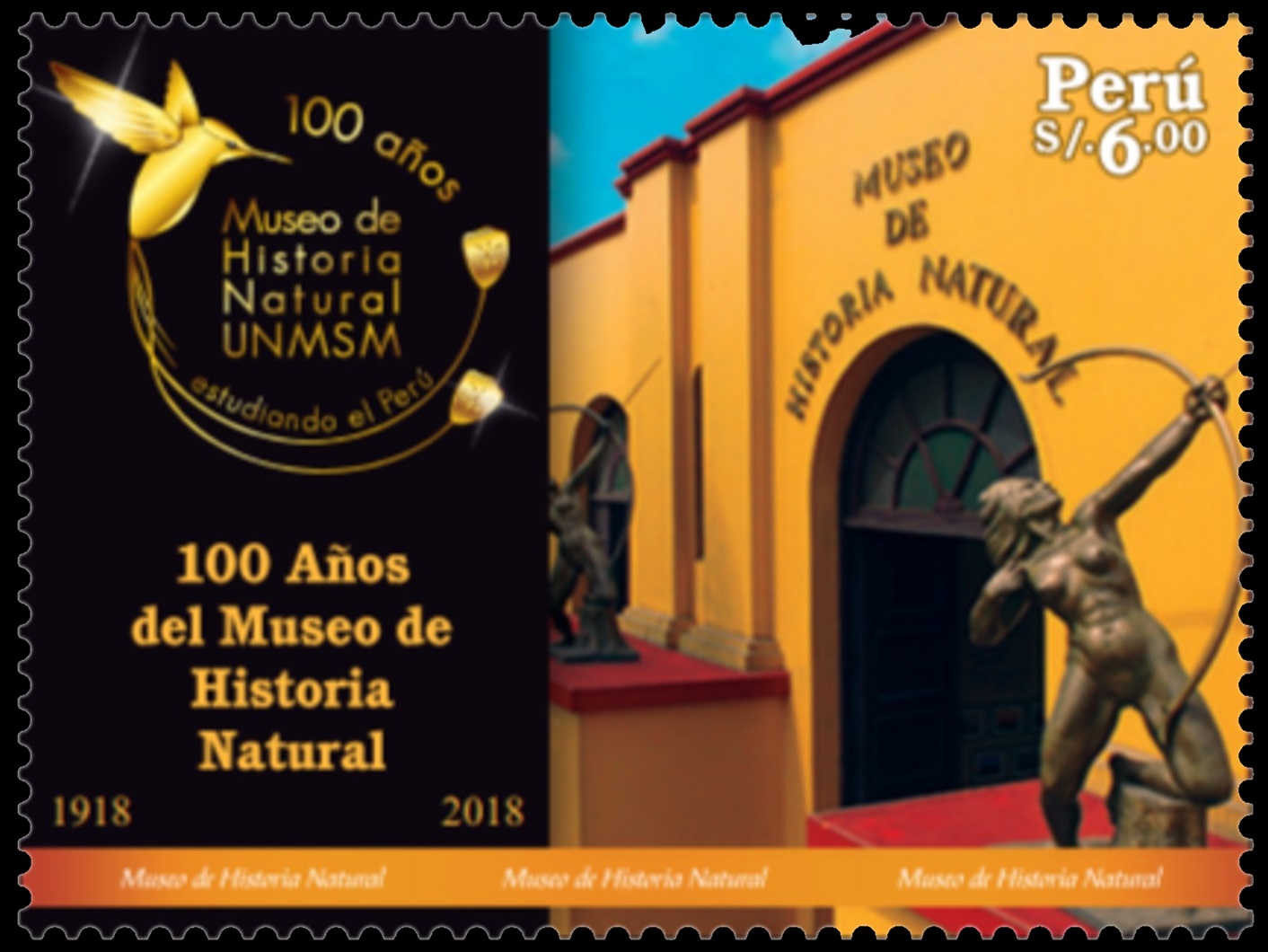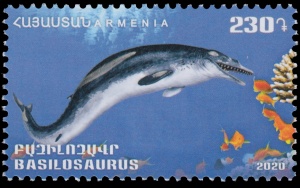Peru 2024 "Prehistoric animals: the Colossal Cetacean (Perucetus colossus)"
| <prev | back to index | next> |
| Issue Date | 02.12.2024 |
| ID | Michel: Bl. 156 (2058), Scott: , Stanley Gibbons: Yvert et Tellier: , Category: pF, pR |
| Design |
Stamp design: Marco Antonio Quispe Yalli. Illustration: Alberto Gennari. |
| Stamps in set | 1 |
| Value | S/. 7.60 - Perucetus colossus |
| Emission/Type | commemorative |
| Issue place | Lima |
| Size (width x height) | stamp: , Mini-Sheet: 100 mm x 80 mm. |
| Layout | Souvenir-Sheet |
| Products | FDC x1 |
| Paper | |
| Perforation | 13.50 x 13.50 |
| Print Technique | Offset lithography, multicolor |
| Printed by | Cartor |
| Quantity | 5.000 |
| Issuing Authority | SERPOST |

On December 2nd, 2024, the Post Authority of Peru - Serpost, issued the Souvenir-Sheet "Prehistoric animals" showing fossils and reconstruction of an early whale from Peru - Perucetus colossus.
The reconstruction of the animal in its coastal habitat was painted in 2023 by Italian artist Alberto Gennari, who is very fond of natural history, prehistoric animals and science fiction. The painting was used in the article published in Nature where this prehistoric animal was described.
Another animal on the Souvenir-Sheet is the sawfish (Pristis sp.) recovered from the same unit in the East Pisco Basin, the Yumaque Member of the Paracas Formation.
Perucetus colossus was a primitive whale from the Basilosauridae family that inhabited along the coast of modern Peru between 37 and 39 million years ago during the Eocene Period.
The first vertebrae was discovered in 2013 by the Peruvian paleontologist Mario Urbina of the Natural History Museum at the University of San Marcos in Lima while he was walking in the Ica valley a few kilometres south of the Zamaca locality, Ica Province, southern Peru, searching for fossils.
Mario Urbina is self-made Peruvian paleontologist and fossil hunter
(who only finished up the second year of high school and never took a single paleontology course)
who spent more than 25 years traveling the desert between
Ica and Arequipa in search of fossils that inhabited the ancient Peruvian sea in
the Cenozoic Period and sacrificed his health.
Among his discoveries are dozens of important fossils, including cetaceans, crocodiles,
sloths, seals, penguins, etc.
The 6 million years old penguin species Spheniscus urbinai and a species
of giant sloth Megatherium urbinai
were named after Mario Urbina who discovered their bones in 2002 and in 2007 respectively.
Most of the fossils discovered by Urbina are in the collection of
the Department of Vertebrate Paleontology of the Museum of Natural History,
a department founded by Mario Urbina together with Dr. Rodolfo Salas Gismondi.
 |
| The Natural History Museum at the University (UNMSM) of San Marcos in Lima on stamp of Peru 2019 MiNr.: 2867, Scott: 1977. |
The first vertebrae of Perucetus were discovered on the surface of the Zamaca Desert, but the rest were buried inside a hill, which had to be removed with hammers to break hard soil. Since each bone unit weighs about 100-150 kg, Urbina led dozens of expeditions, with a team of the Vertebrate Paleontology Department of the Natural History Museum-UNMSM. On each expedition, Urbina and his team collected one or two vertebrae.
In total, after six years of excavations, 13 vertebrae, 4 ribs, and some parts of the pelvic region of the same individual were discovered.
On August 2, 2023, a team of 16 Peruvian and European paleontologists published the results of their study in the journal Nature, naming it Perucetus colossus. The genus name was named after the country and means "whale of Peru" - "cetus" is a whale in Latin. The specific name "colossus" means giant in Greek. The holotype is stored in collection of the Museo de Historia Natural, Universidad Nacional Mayor de San Marcos, Lima, Peru, under the specimen number MUSM 3248.

Unfortunately, the entire skeleton of Perucetus colossus is not known – so the reconstruction created by paleontologists is uncertain and a large part of the skeleton to the back of the skull is based on a related species, Cynthiacetus peruvianus but made larger in size to fit Perucetus colossus. They also used the shape of the tail flukes and the front limbs of a manatee (Trichechus) as a model for the tail and forelimbs of Perucetus.
They used the manatee as a model for their reconstruction due to the similar trend of pachyosteosclerosis – the thickening of the bone and increased bone density observed in this modern animal. Pachyosteosclerosis is a process that is seen in many aquatic vertebrates – thickening their bones as a means of controlling their buoyancy by having the bones act as ballast. The paleontologists did not find the hind limbs of Perucetus – but used Cynthiacetus peruvianusfor a model for this portion of the skeleton as well.
Cynthiacetus is an extinct genus of basilosaurid early whale that lived during the Late Eocene (40.4 to 33.9 million years ago). Specimens have been found in the southeastern United States and Peru. Cynthiacetus peruvianus species was described in 2011, based on sub-complete skeleton, including the skull, which comes from the late Eocene (Priabonian) of the Otuma Formation on the southern coast of Peru, belongs to an adult individual measuring 9 meters long.

|
| Basilosaurus reconstruction on stamp of Armenia 2020, MiNr.: 1148, Scott: 1219. |
Hypotheses about basilosaurs argue that they had an elongated serpentine body and, as an adaptation, developed vertebral pachyosteosclerosis, a bone condition to remain submerged in water.
Many fossils of Basilosaurus are known from Wadi Al-Hitan - a paleontological site in the Al Fayyum Governorate of Egypt, some 150 km southwest of Cairo. The site reveals evidence for the explanation of one of the greatest mysteries of the evolution of whales: the emergence of the whale as an ocean-going mammal from a previous life as a land-based animal.
In 2008 fossils and the sculpture representing a fossil whale Basilosaurus, were commemorated on a pair of postage stamps of Egypt:
 Fossils and the sculpture representing a fossil whale Basilosaurus, Egypt 2008,
MiNr: 2349-2350 ; Scott: 2014.
Fossils and the sculpture representing a fossil whale Basilosaurus, Egypt 2008,
MiNr: 2349-2350 ; Scott: 2014.
As the skull and teeth of Perucetus have not been discovered, its diet is unknown.. Based on the weight of its bones, it was likely a slow-moving inhabitant of shallow waters. Its diet can only be speculated, but one suggestion proposes that it may have fed on benthic animals like crustaceans and molluscs living on the ocean floor.
Such a lifestyle would be comparable to that of the modern grey whale and beluga whale, both of which feed mainly on bottom-dwelling animals— by filter-feeding in the former and by suction in the latter. Another hypothesis is that Perucetus could have been a scavenger like large demersal sharks.
The fact that Perucetus belonged to an extinct group of whales that had different body proportions from living whales also complicates the weight estimates. The bones of Perucetus have a high degree of density, with a volume 350% greater than that of other known basilosaurs, in addition to being compact in almost all their entirety, unlike porous bones that all other animals have. After the excavations, the researchers used 3D scanners to study the surface of the bones and drilled into them to peek inside. They estimated, by scaling to the skeletons of better preserved basilosaurids, that Perucetus had a minimum weight of 86 tons and a maximum of 340 tons, with an average weight of about 199 tons. This estimated weight exceeds that of any known mammal or aquatic vertebrate that ever existed, surpassing the blue whale (130 to 150 tons) and the dinosaur Argentinosaurus (50 to 100 tons).
Some paleontologists disagree with the weight estimation of the research team.
Professor Motani and Dr. Pyenson from the Smithsonian Institute in USA, estimate that the 17-m long Perucetus colossus weighed in at 60 to 70 tons, considerably less than the known weights of blue whales.
Professor Motani argues:
Mammal bones usually have a solid exterior and are spongy or hollow in the center.
Some animals have more of the center filled in with solid bone, making them dense and heavy.
In aquatic animals, heavy bones can offset buoyancy from body fat and blubber, allowing the animal
to maintain neutral buoyancy in water or — in the case of the hippopotamus — to walk on river beds.
The fossil whale bones have both extensive in-filling and extra growth of bone on the outside as well,
a condition called pachyostosis also seen in some modern aquatic mammals, such as manatees.
These estimates [190 tons] would make Perucetus colossus impossibly dense.
It would have been a job for the whale to stay at the surface, or even to leave the sea bottom
— it would have required continuous swimming against gravity to do anything in the water.
The first problem is that the original study used the fossil bones to estimate the weight of
the skeleton, then extrapolated to the weight of the entire animal, assuming that the skeletal
and non-skeletal mass would scale at the same rate with increasing body size.
But measurements of other animals show this is not the case.
The original estimates also overestimated how much overall body mass increases as a result of pachyostosis.
But evidence from manatees shows that their bodies are relatively light relative
to their skeletal mass.
Products
| FDC | First-Day-of-Issue Postmark | Example of Circulated Cover |
 |
 |
 |
References

|
- Technical details: Serpost, Info Brochure.
- Perucetus:
Wikipedia,
National Geographic,
SCI News,
CBC news,
El Pais,
Natural History Museum Stuttgart,
Spektrum (in German),
"A heavy weight early whale pushes the boundaries of vertebrate morphology", published on 02 August 2023 in journal Nature, - Cynthiacetus:
Wikipedia,
Manuel Martínez-Cáceres, Olivier Lambert, Christian De Muizon. "The anatomy and phylogenetic affinities of Cynthiacetus peruvianus, a large Dorudon-like basilosaurid (Cetacea, Mammalia) from the late Eocene of Peru". Geodiversitas , 2017, 39 (1), pp.7 - 163. - Mario Urbina: El Pais,
- Alberto Gennari: official blog, Facebook,
Additional YouTube Videos

|
Acknowledgements
Many thanks to Dr. Peter Voice from Department of Geological and Environmental Sciences, Western Michigan University, for reviewing the draft page and his very valuable comments.| <prev | back to index | next> |